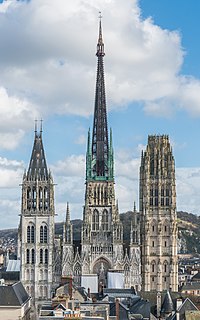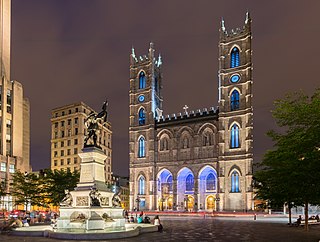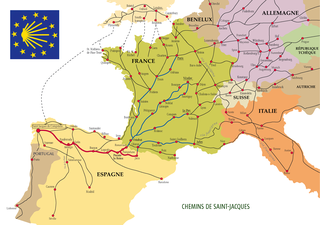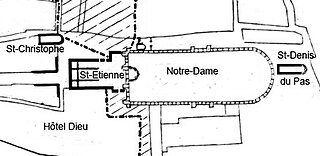
Notre-Dame de Paris, referred to simply as Notre-Dame, is a medieval Catholic cathedral on the Île de la Cité, in the 4th arrondissement of Paris. The cathedral, dedicated to the Virgin Mary, is considered one of the finest examples of French Gothic architecture. Several of its attributes set it apart from the earlier Romanesque style, particularly its pioneering use of the rib vault and flying buttress, its enormous and colourful rose windows, and the naturalism and abundance of its sculptural decoration. Notre Dame also stands out for its musical components, notably its three pipe organs and its immense church bells.

Rose window is often used as a generic term applied to a circular window, but is especially used for those found in Gothic cathedrals and churches. The windows are divided into segments by stone mullions and tracery. The term rose window was not used before the 17th century and according to the Oxford English Dictionary, among other authorities, comes from the English flower name rose.

The Cathedral Basilica of Our Lady of Amiens, or simply Amiens Cathedral, is a Roman Catholic church. The cathedral is the seat of the Bishop of Amiens. It is situated on a slight ridge overlooking the River Somme in Amiens, the administrative capital of the Picardy region of France, some 120 kilometres north of Paris.

In French Gothic architecture, Rayonnant is the period from about the mid-13th century to mid-14th century. It was characterized by a shift away from the High Gothic search for increasingly large size toward more spatial unity, refined decoration, and additional and larger windows, which filled the space with light. Prominent features of Rayonnant include the large rose window, more windows in the upper-level clerestory; the reduction of the importance of the transept; and larger openings on the ground floor to establish greater communication between the central vessel and the side aisles. Interior decoration increased, and the decorative motifs spread to the outside, to the facade and the buttresses. utilizing great scale and spatial rationalism towards a greater concern for two-dimensional surfaces and the repetition of decorative motifs at different scales. The use of tracery gradually spread from the stained glass windows to areas of stonework, and to architectural features such as gables.

Rouen Cathedral is a Roman Catholic church in Rouen, Normandy, France. It is the see of the Archbishop of Rouen, Primate of Normandy. It is famous for its three towers, each in a different style. The cathedral, built and rebuilt over a period of more than eight hundred years, has features from Early Gothic to late Flamboyant and Renaissance architecture. It also has a place in art history as the subject of a series of impressionist paintings by Claude Monet.

Paul Abadie was a French architect and building restorer. He is considered a central representative of French historicism. He was the son of architect Paul Abadie Sr.

The Church of St. Eustache, Paris is a church in the 1st arrondissement of Paris. The present building was built between 1532 and 1632.

The Church of Saint-Germain-l'Auxerrois is a Roman Catholic church in the First Arrondissement of Paris, situated at 2 Place du Louvre, directly across from the Louvre Palace. It was named for Germanus of Auxerre, the Bishop of Auxerre (378-448), who became a papal envoy and who met Saint Genevieve, the patron Saint of Paris, on his journeys. Genevieve is reputed to have converted the queen Clotilde and her husband, French King Clovis I to Christianity at the tomb of Saint Germain in Auxerre.

French Gothic architecture is an architectural style which emerged in France in 1140, and was dominant until the mid-16th century. The most notable examples are the great Gothic cathedrals of France, including Notre-Dame Cathedral, Reims Cathedral, Chartres Cathedral, and Amiens Cathedral. Its main characteristics were the search for verticality, or height, and the innovative use of the rib vault and flying buttresses and other architectural innovations to distribute the weight of the stone structures to supports on the outside, allowing unprecedented height and volume, The new techniques also permitted the addition of larger windows, including enormous stained glass windows, which filled the cathedrals with light. The French style was widely copied in other parts of northern Europe, particularly Germany and England. It was gradually supplanted as the dominant French style in the mid-16th century by French Renaissance architecture.

Notre-Dame Basilica is a basilica in the historic district of Old Montreal, in Montreal, Quebec, Canada. The church is located at 110 Notre-Dame Street West, at the corner of Saint Sulpice Street. It is located next to the Saint-Sulpice Seminary and faces the Place d'Armes square.

Early Gothic is the style of architecture that appeared in northern France, Normandy and then England between about 1130 and the mid-13th century. It combined and developed several key elements from earlier styles, particularly from Romanesque architecture, including the rib vault, flying buttress, and the pointed arch, and used them in innovative ways to create structures, particularly Gothic cathedrals and churches, of exceptional height and grandeur, filled with light from stained glass windows. Notable examples of early Gothic architecture in France include the ambulatory and facade of Saint-Denis Basilica; Sens Cathedral (1140); Laon Cathedral; Senlis Cathedral; (1160) and most famously Notre-Dame de Paris.

UNESCO designated the Routes of Santiago de Compostela in France as a World Heritage Site in December 1998. The routes pass through the following regions of France: Aquitaine, Auvergne, Basse-Normandie, Bourgogne, Centre, Champagne-Ardenne, Ile-de-France, Languedoc-Roussillon, Limousin, Midi-Pyrénées, Picardie, Poitou-Charentes, and Provence-Alpes-Côte d'Azur. UNESCO cites the routes' role in "religious and cultural exchange", the development of "specialized edifices" along the routes, and their "exceptional witness to the power and influence of Christian faith among people of all classes and countries in Europe during the Middle Ages".
Pierre Gaudin (1908–1973), son of Jean Gaudin (1879–1954) and grandson of Félix Gaudin (1851–1930) was a glass painter and mosaic artist. His studio executed mosaic designs and stained-glass windows for the Basilica of St. Thérèse, Lisieux. Gaudin had a daughter, Sylvie Gaudin and Catherine Aboulian

Saint-Esprit is a Catholic church in the 12th arrondissement of Paris, France, in the southeast of the city.

The Basilica of Notre-Dame d'Alençon is a Gothic parish church located in Alençon, Orne, France. It was elevated to the rank of minor basilica by Pope Benedict XVI in 2009.

Charles Jean Baptiste Claude Lorin was a French glass painter and manufacturer. He was born on October 16, 1866, in Chartres, the capital of the Eure-et-Loir department in France, and died in the same city on April 23, 1940.

Romanesque architecture appeared in France at the end of the 10th century, with the development of feudal society and the rise and spread of monastic orders, particularly the Benedictines, which built many important abbeys and monasteries in the style. It continued to dominate religious architecture until the appearance of French Gothic architecture in the Île-de-France between about 1140–1150.

Gothic cathedrals and churches are religious buildings created in Europe between the mid-12th century and the beginning of the 16th century. The cathedrals are notable particularly for their great height and their extensive use of stained glass to fill the interiors with light. They were the tallest and largest buildings of their time and the most prominent examples of Gothic architecture. The appearance of the Gothic cathedral was not only a revolution in architecture; it also introduced new forms in decoration, sculpture, and art.
French Gothic stained glass windows were an important feature of French Gothic architecture, particularly cathedrals and churches built between the 12th century and 16th century. While stained glass had been used in French churches in the Romanesque period, the Gothic windows were much larger, eventually filling entire walls. They were particularly important in the High Gothic cathedrals, most famously in Chartres Cathedral. Their function was to fill the interior with a mystical colored light, representing the Holy Spirit, and also to illustrate the stories of the Bible for the large majority of the congregation who could not read.

The Basilica and Cathedral of Saint-Étienne in Paris, on the Île de la Cité, was an early Christian church that preceded Notre-Dame de Paris. It was built in the 4th or 5th century, directly in front of the location of the modern cathedral, and just 250 meters from the royal palace. It became one of the wealthiest and most prestigious churches in France. Nothing remains above the ground of the original cathedral. It was demolished beginning in about 1163, when construction began on Notre-Dame de Paris. Vestiges of the foundations remain beneath the pavement of the square in front of Notre-Dame and beneath the west front of the cathedral. The church was built and rebuilt over the years in the Merovingian, Carolingian and Romanesque architectural styles.


















